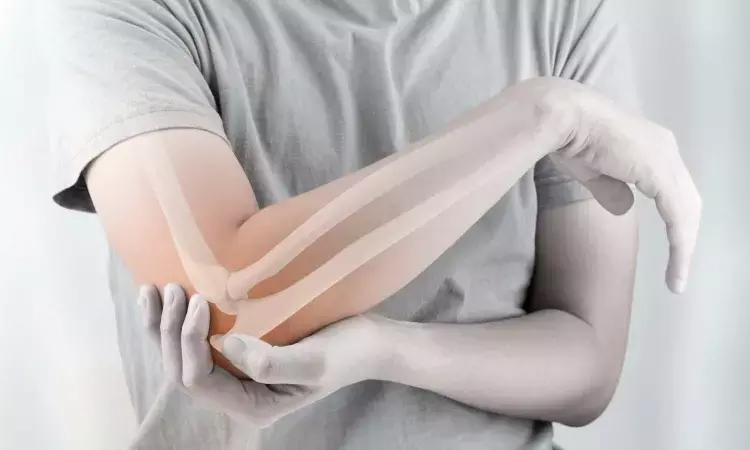- Home
- Medical news & Guidelines
- Anesthesiology
- Cardiology and CTVS
- Critical Care
- Dentistry
- Dermatology
- Diabetes and Endocrinology
- ENT
- Gastroenterology
- Medicine
- Nephrology
- Neurology
- Obstretics-Gynaecology
- Oncology
- Ophthalmology
- Orthopaedics
- Pediatrics-Neonatology
- Psychiatry
- Pulmonology
- Radiology
- Surgery
- Urology
- Laboratory Medicine
- Diet
- Nursing
- Paramedical
- Physiotherapy
- Health news
- Fact Check
- Bone Health Fact Check
- Brain Health Fact Check
- Cancer Related Fact Check
- Child Care Fact Check
- Dental and oral health fact check
- Diabetes and metabolic health fact check
- Diet and Nutrition Fact Check
- Eye and ENT Care Fact Check
- Fitness fact check
- Gut health fact check
- Heart health fact check
- Kidney health fact check
- Medical education fact check
- Men's health fact check
- Respiratory fact check
- Skin and hair care fact check
- Vaccine and Immunization fact check
- Women's health fact check
- AYUSH
- State News
- Andaman and Nicobar Islands
- Andhra Pradesh
- Arunachal Pradesh
- Assam
- Bihar
- Chandigarh
- Chattisgarh
- Dadra and Nagar Haveli
- Daman and Diu
- Delhi
- Goa
- Gujarat
- Haryana
- Himachal Pradesh
- Jammu & Kashmir
- Jharkhand
- Karnataka
- Kerala
- Ladakh
- Lakshadweep
- Madhya Pradesh
- Maharashtra
- Manipur
- Meghalaya
- Mizoram
- Nagaland
- Odisha
- Puducherry
- Punjab
- Rajasthan
- Sikkim
- Tamil Nadu
- Telangana
- Tripura
- Uttar Pradesh
- Uttrakhand
- West Bengal
- Medical Education
- Industry
Living kidney donors have lower risk of all types of fractures but excess risk of vertebral fractures: JAMA

USA: A recent survey study comprising 2132 living kidney donors and 2014 controls revealed a significantly lower overall rate of fractures among donors than controls. However, vertebral fractures were significantly more common among donors than controls.
After a mean follow-up of 25 years, the study found a lower rate of overall fractures but an excess of vertebral fractures among living kidney donors compared with controls. Treating excess vertebral fractures with dietary supplements such as vitamin D3 may decrease patient morbidity and the number of vertebral fractures. The study findings were published online in JAMA Network Open on January 24, 2024.
There has been an increase in the prevalence of living kidney donation. Each year, about 30,000 persons worldwide become living kidney donors. Previous studies have shown an increased risk of fractures in living kidney donors due to lower concentrations of serum 1,25-dihydroxyvitamin D, reductions in kidney mass, and secondary increases in serum parathyroid hormone.
Against the above background, Hilal Maradit Kremers, Mayo Clinic, Rochester, Minnesota, and colleagues aimed to compare the overall and site-specific fracture risk among living kidney donors with strictly matched controls from the general population who would have been eligible to donate a kidney but did not do so.
For this purpose, the research team conducted a survey study between 2021 and 2023. 5065 living kidney donors from 3 large transplant centres in Minnesota were invited to complete a survey about their history of fractures and bone health and 16 156 population-based nondonor controls without a history of comorbidities were identified from the Rochester Epidemiology Project that would have precluded kidney donation and completed the same survey. 2132 living kidney donors and 2014 nondonor controls responded to the survey.
The rates of site-specific and overall fractures were compared between living kidney donors and controls using standardized incidence ratios (SIRs).
The study led to the following findings:
- At the time of the survey, the 2132 living kidney donors had a mean age of 67.1 years and included 58.4% of women, and the 2014 controls had a mean age of 68.6 years and included 56.6% of women.
- The mean time between the donation or index date and the survey date was 24.2 years for donors and 27.6 years for controls.
- The overall rate of fractures among living kidney donors was significantly lower than among controls (SIR, 0.89).
- There were significantly more vertebral fractures among living kidney donors than among controls (SIR, 1.42).
"In the study, we observed a reduction in overall fractures but an excess risk of vertebral fractures among living kidney donors compared with controls after a mean follow-up of 25 years," the researchers wrote.
"Treating excess vertebral fractures with dietary supplements such as vitamin D3 may reduce the number of vertebral fractures and patient morbidity," they suggested.
Reference:
Maradit Kremers H, Grossardt BR, Miller AR, et al. Fracture Risk Among Living Kidney Donors 25 Years After Donation. JAMA Netw Open. 2024;7(1):e2353005. doi:10.1001/jamanetworkopen.2023.53005
Dr Kamal Kant Kohli-MBBS, DTCD- a chest specialist with more than 30 years of practice and a flair for writing clinical articles, Dr Kamal Kant Kohli joined Medical Dialogues as a Chief Editor of Medical News. Besides writing articles, as an editor, he proofreads and verifies all the medical content published on Medical Dialogues including those coming from journals, studies,medical conferences,guidelines etc. Email: drkohli@medicaldialogues.in. Contact no. 011-43720751


